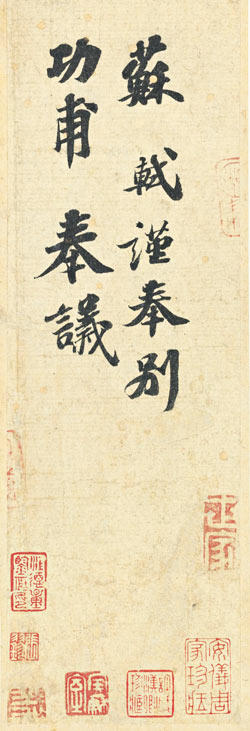The international auction house Sotheby's insisted on Sunday on the authenticity of a calligraphy artwork bought by a Chinese collector for $8.2 million this year, despite the challenge from three Chinese experts who say it is fake.
|
 |
|
The Gong Fu Tie calligraphy was bought by Chinese collector Liu Yiqian from Sotheby's in September. Provided to China Daily |
Over the weekend, the three scholars from the Shanghai Museum said they were about to deliver a research report on a copying method used in creating fake works of calligraphy, including evidence that the Gong Fu Tie calligraphy, said to be by artist Su Shi (1037-1101), was produced using this method.
If they are right, the piece was created in the 19th century, about 800 years after its supposed creator died.
Experienced collector Liu Yiqian bought the work, originally valued at between $300,000 and $500,000, at a Sotheby's auction in New York in September.
The work, just nine characters long, had been described as one of the finest examples of calligraphy ever produced and had been studied by scholars for centuries.
"Sotheby's firmly stands by the attribution of the Gong Fu Tie calligraphy to the Song Dynasty poet Su Shi," Andrew Gully, worldwide director of communications for the auction house, said in an e-mail interview on Sunday.
"We have not yet been presented with the report referenced in recent media accounts, but take all matters of authenticity seriously and look forward to reviewing and responding to any questions raised," he added.
"Sotheby's adheres to the highest ethical standards in the marketplace and reserves all of its legal rights in this matter."
Liu, 50, a successful entrepreneur and a co-founder of the Shanghai-based Long Museum, said on Sunday that the auction house has promised to organize worldwide museum experts to appraise the work's authenticity, in view of the report to be delivered by the Shanghai Museum.
He said he will ask for a refund if the work is proved a counterfeit.
"Sotheby's has assured me that if the Shanghai Museum is right on the calligraphy, they will take steps to safeguard buyers' interests as well as their reputations," he said. But if experts from around the world agree that the Shanghai Museum is wrong, Sotheby's will also try to safeguard its reputation through other means, he added.
The calligraphic work has gained approval from at least two late collecting masters, according to Liu. Xu Bangda (1911-2012) and Zhang Congyu (1914-1963) hailed the artwork as a top-grade piece in their published manuscripts or anthologies.
"I never heard any contrary opinion about the calligraphy before," Liu said, adding he has no idea why the piece became controversial all of a sudden.
But the controversy is a good thing, Liu said. "It will help reveal the truths of history."
The three researchers from the Shanghai Museum, founded in 1952, could not be reached for comment on Sunday.
Chen Yunke, a press officer at the museum, said the trio are respectable scholars with profound expertise in the appraisal of ancient artworks.
One of the scholars is the museum's former director of Chinese paintings and calligraphy Shan Guolin, and another is senior connoisseur Zhong Yinlan. "They worked for their entire life at the Shanghai Museum before their retirement," Chen said.
The third researcher is Ling Lizhong, who still works for the museum.
They claim the Gong Fu Tie calligraphy is a counterfeit created some time between 1820 and 1871 using the conventional reproduction method of covering the original calligraphy with a sheet of paper with better transparency, drawing the outline of each character with a thin brush, and then filling it in with ink.
The artwork had been scheduled to go on display from March 28 in a new chamber to be opened at the Long Museum.
wangzhenghua@chinadaily.com.cn
|
|
|
|
|
|
|
|
